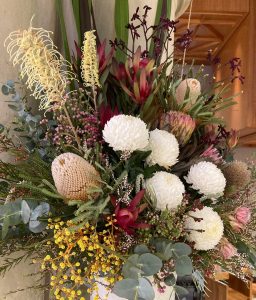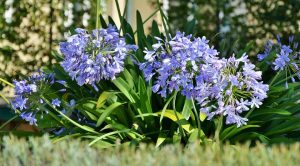 Flowers in Church
Flowers in Church
One decorative item that plays an important atmospheric role in liturgical contexts is the floral arrangement. Natural flowers and plants have long been associated with celebrations of the liturgy – Eucharist, weddings, funerals – as well as devotions associated with the Blessed Virgin Mary and the Blessed Sacrament. This tradition sits well with influential voices such as Pope Francis; his encyclical Laudato Si’ has called for a renewed appreciation for the natural world as God’s gift, a blessing that is vital for our common, human life but also one that is vulnerable to misuse.
Natural flowers and plants of different colours, shapes and sizes reflect the boundless beauty and variety of God’s creative hand, for which we give particular thanks during the Liturgy of the Eucharist. However, flower arrangements do not need to be overdone. One or two beautiful arrangements provided by the parish, parishioners or local producers are better than multiple arrangements that may look haphazard and clutter the worship space. Their scale should fit the space and not be placed so that they cover the altar or ambo.



The General Instruction of the Roman Missal (2012) uses the term ‘moderation’ in relation to flowers for Mass. It says that during Advent the floral decoration of the altar should be marked by a moderation suited to the character of this time of year, without expressing in anticipation the full joy of the Nativity of the Lord. During Lent it is forbidden for the altar to be decorated with flowers. Exceptions, however, are Laetare Sunday (Lent IV), Solemnities and Feasts. Floral decoration should always show moderation and be arranged around the altar rather than on the altar table (GIRM 305).
Natural flora may also help to underscore the liturgical colours of the Church’s seasons (Advent-Christmas, Lent-Holy Week-Easter-Pentecost) and sacramental rites. An obvious choice in Australia might be Jacaranda or Agapanthus (violet-purple variety) during the Season of Advent. These plants are easy to grow, hardy, and flower at the right time. Other options might be Cypress (for Ash Wednesday and Palm Sunday), Date Palms (these require considerable space) for Holy Week, plants with red or orange displays (Poinsettia or Bird of Paradise) for Pentecost, and so forth.


Of course, we are talking here of real flowers and plants. They speak of God’s creation in a way that artificial flowers and greenery never can. The whole point of natural flowers is that they wither and die, echoing the Gospel metaphor of God’s providence; they are a sign of the Paschal mystery, of life, death and resurrection. The same dusty artificial arrangement week in and week out is a negative sign. When cut flowers are not possible, perhaps a flourishing pot plant (philodendron or monstera) would also be a good sign of God’s beautiful creation.
A Church Garden
With these guidelines in mind, one suggestion for older and newer parishes to consider is the strategic planting of their own supply of flowers, shrubs or trees in parish church gardens that might help to supply annual, natural flowers and foliage for the different seasons of the year. Parishes with florists in the local community may be in a position to afford to purchase flowers for special occasions, perhaps Christmas Poinsettia, Easter Lilies or Daisies or others that are appropriate for different seasons and celebrations.


The idea of a church garden raises many other exciting possibilities. Good landscaping can, for example, be a sign of hospitality when people are welcomed to the church by a well-kept and colourful courtyard. A garden might provide a beautiful prayer or meditation space, perhaps centred on a cross or an image of the parish patron saint. As a reminder of the Garden of Eden and God’s work of creation, it stands also as a sign of the kingdom of heaven.


 A parish garden further evokes the memories of the monastic cloister which was not only a place of refreshing quiet but also a source of food and medicine. Various herbs for cooking and plants with medicinal properties were raised, along with fruit trees and vegetables.
A parish garden further evokes the memories of the monastic cloister which was not only a place of refreshing quiet but also a source of food and medicine. Various herbs for cooking and plants with medicinal properties were raised, along with fruit trees and vegetables.
This in turn raises the possibility of a parish sponsoring a local community garden. This would not only furnish flowers for the church but could also be an outreach to those in need. Here the full dimensions of Laudato Si’ come into play. A Catholic parish in Adelaide embraced the opportunity for church and school to work together and to provide gifts to migrant and refugee families: they would make soup and distribute it through Mini Vinnies. A Uniting Church parish in Port Melbourne built 27 raised garden beds; they see the garden as a means of bringing people together to share expertise and to demonstrate organic, sustainable, eco-friendly urban living (above). Produce is available to all for personal use. The Anglican Parish of St Luke at Mosman Park used an idle tennis court. Their garden includes citrus trees, a herb garden, and a bush tucker garden.
 Conclusion
Conclusion
Different geographical regions and latitudes within Australia’s states and territories will offer their own distinctive possibilities and colourings. Local flowers and plants help to anchor the liturgy in a particular place. This is a process called ‘inculturation’. Australian native plants and flowers speak of the landscape where we live and worship.
Appropriate selections, imaginative arrangements and careful positioning of flowers, both inside the church building and outside in the church grounds, help to enhance the prayerful participation of the community. The very act of placing flowers may be an act of devotion, a prayer in action. How poignant to decorate the church interior with appropriate flowers from God’s creation that are sourced from the parish’s own garden, planted and cared for by parishioners themselves.
Dr Paul Taylor is executive secretary of the Bishops Commission for Liturgy of the Australian Catholic Bishops Conference. With contributions from other members of the National Liturgical Architecture and Art Council.
